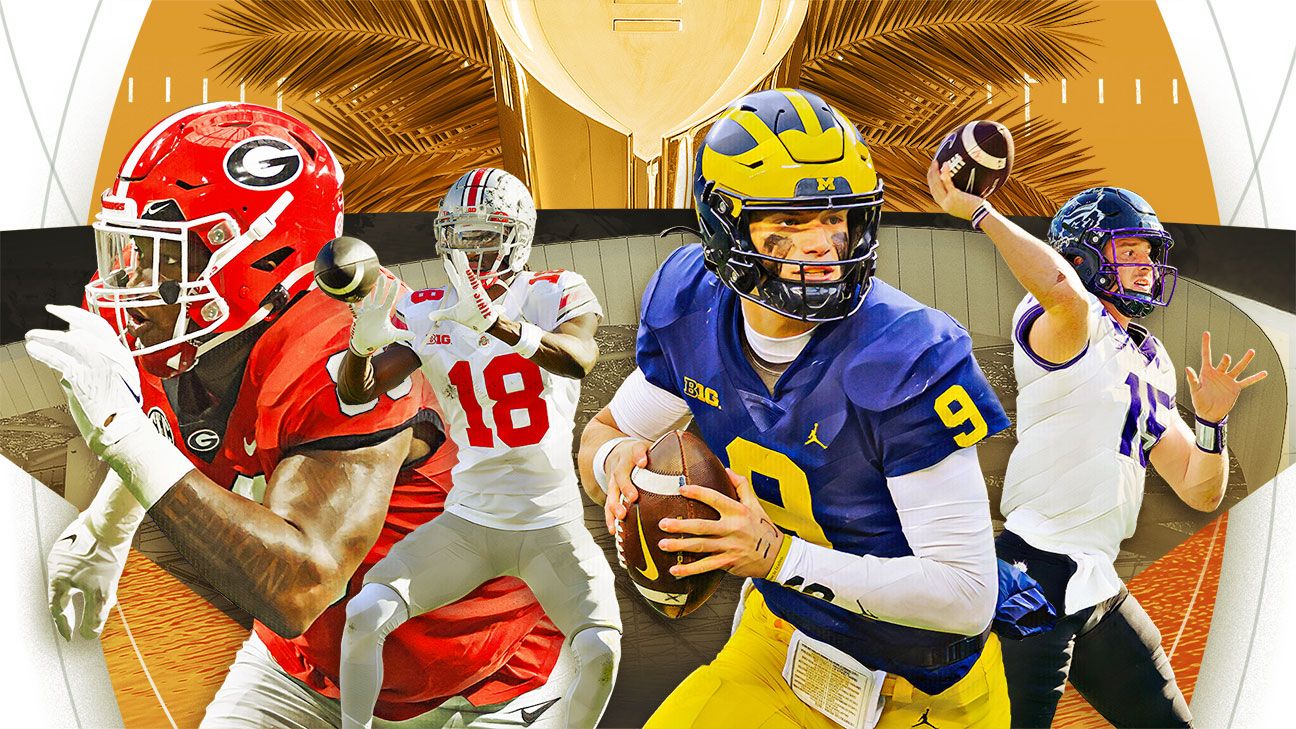Nick Saban tried. Alabama‘s coach found whatever megaphone was available to him Saturday night to plead the Crimson Tide’s case to make the College Football Playoff.
He suggested looking at the top four through the lens of, “How are they playing at the present?” He asked, “If we played these teams in question, would we be underdogs in the game or not?”
But the committee didn’t budge. Betting lines aren’t part of its criteria, after all. It meets in Grapevine, Texas, not in Las Vegas.
There would be no leapfrogging Ohio State or TCU. In the end, the math was simple: The top three of Georgia, Michigan and TCU remained the same, out went USC by virtue of a second loss in the Pac-12 championship game, and in slipped the Buckeyes, who moved up one spot to No. 4. Which means, for just the second time since the CFP began in 2014, Alabama will not be part of the semifinal round.
So we have new blood: The Horned Frogs become the first team from the Big 12 not named Oklahoma to reach the playoff.
And we have an old rivalry: The Buckeyes and Wolverines will play their respective semifinal games for a chance to meet for the national championship.
And we have a chance for some more history: Georgia is seeking to become the first repeat champion of the CFP era.
Here’s a first look at the semifinal games.


No. 1 Georgia vs. No. 4 Ohio State
CFP Semifinal at the Chick-fil-A Peach Bowl
When: Saturday, Dec. 31 at 8 p.m. ET
Where: Mercedes-Benz Stadium, Atlanta
How to watch: ESPN and ESPN App
Opening line via Caesars Sportsbook: Georgia by 6.5
Georgia built the most complete résumé in college football this season. It was dominant in its biggest games: a 49-3 win over then-No. 11 Oregon in the season opener, a 27-13 win over then-No. 1 Tennessee in the first week in November and a 50-30 win over then-No. 14 LSU in the SEC championship game Saturday.
The Bulldogs’ reward: the CFP top seed and the opportunity to stay close to home and play in Atlanta for the third time this season. Quarterback Stetson Bennett said he didn’t know whether it was the turf or the humidity in Mercedes-Benz Stadium, but, “I mean, we like this place. We play pretty good here.”
But Ohio State travels well. The Buckeyes survived a 45-23 loss at home to Michigan to end the regular season, and got the nod from the playoff committee over Alabama, which lobbied to get into the top four.
The game — just the second matchup of the schools in their history, and the first since 1993 — represents a clash in styles. Georgia is built on defense, a strong running game and is complemented by a savvy veteran quarterback. Ohio State has a potent offense, headlined by Heisman Trophy candidate quarterback C.J. Stroud and maybe the best receiver in college football in Marvin Harrison Jr. But its defense has a lot to prove after getting trounced by Michigan.
Georgia
Key player: Georgia’s defense shouldn’t be this good again. Repeating last season’s success would have been hard enough, even if it had not lost five first-round draft picks to the NFL. But maybe the most talented player on that defense from a year ago — Jalen Carter — did come back. And after dealing with nagging injuries the first half of the season, he has showed what a game-wrecker he can be of late. In his past six games, he had 24 tackles, 6.5 tackles for loss, three sacks and two forced fumbles. Big and strong enough to plug the running lanes, and quick and agile enough to rush the passer, Carter must be accounted for.
X factor: Georgia’s offense is effective, of course. It has a three-headed monster at running back with Kenny McIntosh, Kendall Milton and Daijun Edwards. And quarterback Stetson Bennett is a threat whether he’s throwing from the pocket or scrambling for yards. What’s more, he has mismatches at tight end in Brock Bowers and Darnell Washington to lean on. But who’s the go-to receiver? Who’s the deep threat? Ladd McConkey is solid with 51 receptions and five touchdowns, but those aren’t exactly eye-popping numbers, and he’s undersized at 6-foot. Fellow receivers Marcus Rosemy-Jacksaint and Dillon Bell have only two touchdowns apiece.
How Georgia wins: The formula isn’t terribly complicated. Kirby Smart built the Bulldogs to win the line of scrimmage on both sides of the ball. So start from the inside out. Carter and the defensive line suffocate the running game (2.97 yards per rush during the regular season, sixth lowest in the FBS) and get in the face of the quarterback (31% pressure rate). Meanwhile, the offensive line powers a strong running game (5.5 yards per rush, eighth best among Power 5 teams) and protects the quarterback (seven sacks, tied for second fewest in the FBS). Throw in a savvy veteran quarterback (Bennett) and an All-America tight end (Bowers), and all the ingredients to reach the national championship game are there.
First take from coach Kirby Smart: “We’ve played really good complementary football, but we can’t play the kind of defense we played last night [against LSU] and expect to be any kind of champion, semifinal or national championship. So we’ve got some work to do and I know our guys will be excited to get back to work. … It really boils down to how you play, not who you play.” — Alex Scarborough
Ohio State
Key player: Quarterback C.J. Stroud had a Heisman-type season going until the Michigan game, with 3,330 passing yards, 37 touchdowns and six interceptions on the year. Stroud threw for 349 yards and two touchdowns against the Wolverines but also had two interceptions. The Buckeyes were dealing with injuries to running back TreVeyon Henderson and Miyan Williams, while freshman Dallan Hayden had just two carries. With converted linebacker Chip Trayanum getting most of the carries, Stroud becomes that much more important if Ohio State isn’t fully healthy at running back. He has been the leader of the offense this season, and while the loss to rival Michigan was a big setback, he can make up for it in the playoffs.
X factor: Wide receiver Marvin Harrison Jr. is one of the best receivers in the country. He has continuously made ridiculous catches throughout the season and makes plays most receivers can’t. The Buckeyes are dealing with injuries to the ground game and have also been without receiver Jaxon Smith-Njigba, so Harrison is vital to the offense on this stage. If he can provide a reliable target for Stroud and get in the end zone, Ohio State should be able to hang with any of the other semifinalists.
How Ohio State wins: The defense needs to limit big plays. It has done a good job of limiting explosive plays all season but showed some weaknesses against the Wolverines, who were able to score multiple long touchdowns through the air and on the ground. The offense has proved that it can put points on the board, but now the defense has to meet the challenge of playing a top-notch offense and have its best game yet.
First take from coach Ryan Day: “Life is all about opportunity and what an unbelievable opportunity this is, going down to Atlanta and playing the national champs. … This is all going to be about taking advantage of this opportunity. Now we’re back in control of our destiny, which we weren’t, and that was the hardest thing going into this past weekend.” — Tom VanHaaren


No. 2 Michigan vs. No. 3 TCU
CFP Semifinal at the Vrbo Fiesta Bowl
When: Saturday, Dec. 31 at 4 p.m. ET
Where: State Farm Stadium, Glendale, Arizona
How to watch: ESPN and ESPN App
Opening line via Caesars Sportsbook: Michigan by 9.5
Michigan avoided a semifinal rematch with Ohio State and instead will take on No. 3 TCU.
The Horned Frogs are coming off of an emotional loss to Kansas State in the Big 12 championship game, while Michigan won the Big Ten title game by beating Purdue.
The Wolverines have the advantage of experience over TCU, having made the playoff last season, but neither team has made it past the semifinals in the CFP era.
Michigan
2:06
Michigan coach Jim Harbaugh gives his initial thoughts on facing TCU in the College Football Playoff.
Key player: Running back Donovan Edwards had 216 rushing yards and two touchdowns in Michigan’s win against Ohio State. With Blake Corum out, Edwards’ performance will be key for the Wolverines. The run game is critical to the Michigan offense, and Edwards’ ability to establish the run and open up the passing game will be a key for the Wolverines.
X factor: Michigan has been a second-half team all season, with a plus-186 point differential after halftime. That is the second-highest margin for any FBS team through 12 games over the past 10 years. The Wolverines have been able to wear out their opponents in every game and have not shown any signs that they will slow down after outscoring Ohio State 28-3 in the final regular-season game and Purdue 29-9 in the Big Ten championship game. Coach Jim Harbaugh has praised strength and conditioning coach Ben Herbert for those second-half surges, which have been a signature for Michigan all season.
How Michigan wins: If the Wolverines can establish their running game and control the clock as they have all season, plus mix in some big plays through the air from quarterback J.J. McCarthy, they should have a good shot. McCarthy has continuously called this a “smashfest” team, and the Wolverines relish beating their opponents up front. Michigan showed it can strike through the air if it has to against Ohio State, but its ideal scenario is having success on the ground first.
First take from coach Jim Harbaugh: “I couldn’t be more impressed with TCU watching them throughout the season and in [Saturday’s] ballgame. That quarterback [Max Duggan] was unbelievable in terms of a competitor — and we’ve got a good one ourselves, too — so it should be a heck of a matchup.” — Tom VanHaaren
TCU
Key player: Max Duggan attempted another wild comeback Saturday against Kansas State, but the Frogs came up just short for the first time in six of those scratch-and-claw games this season. But Duggan has been unflappable, never more so than in a late comeback win on the road at Baylor, when he led two fourth-quarter scoring drives without TCU’s best running back (Kendre Miller, who has 1,342 rushing yards this season, the most at TCU since LaDainian Tomlinson in 2000), top two receivers (Quentin Johnston and Derius Davis) and no timeouts. Duggan has thrown for 3,321 yards and 30 touchdowns to just four interceptions, and his 25 career rushing touchdowns are in the top 10 in school history. Duggan calmly piloted the Frogs to victory after falling behind by 17 to Oklahoma State and 18 to Kansas State in the regular season. That’s why he’s a leading contender for the Heisman Trophy.
X factor: Quentin Johnston. The 6-4, 215-pound junior receiver is a big-play threat with first-round draft potential but has been hobbled for much of the season. When TCU has turned to him, he has been huge, including a key third-down catch with the game on the line in the fourth quarter at Texas, and a 55-yard touchdown catch down late against Kansas State. The Horned Frogs were able to rest him against Iowa State to get him ready for the postseason. When he was healthy, Johnston showed his potential with a two-game stretch against Oklahoma State and on the road against Kansas, when he combined for 22 catches for 386 yards and two touchdowns. On Saturday against Kansas State, he caught four passes for 139 yards. A return to that type of threat would be a huge boost for TCU.
How TCU wins: The Frogs have employed a mix of thunder and lightning to keep opponents on the ropes, particularly in the second half. TCU had 17 plays of at least 50 yards this season, second only to Tennessee in the FBS. Duggan ranks third nationally in completion percentage on passes of 20 or more yards downfield at a 54.7% clip with 12 touchdowns on such plays, tops in the country. And Miller rushed for more than 1,000 yards between the tackles and is tough to bring down, ranking third in the Big 12 with 650 yards after contact. If the Frogs can remain patient and pound away with Miller, they’ll be able to open up the field for their playmakers and a roster loaded with speed.
First take from coach Sonny Dykes: “Our guys are excited to get the bad taste out of their mouth and to work and fix our problems and address the issues we had [in Saturday’s loss in the Big 12 championship game]. I’m fired up about the way our guys are improving and we look forward to a big challenge. Michigan obviously is a very explosive football team. … I was very impressed with their quarterback, their skill and in particular their offensive line.” — Dave Wilson
